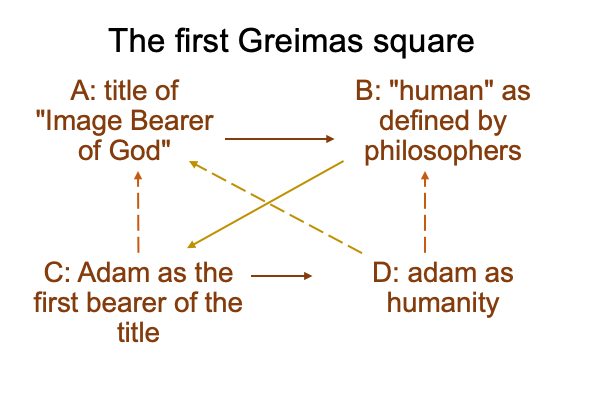0105 Here is the first applied Greimas square appearing in this examination of Loke’s book (point 0011).

0106 The title, “Image Bearer of God”, is the focal term (A). God makes him in His image. Male and female He creates them. Does this sequence reflect some chauvinistic attitude of the ancient Near East? Is this an artifact of translation? Right after the Creation Story, God directly fashions Adam from the earth and Eve from Adam’s side. Theologians may debate, but the debate somehow does not recognize that the Genesis Creation Story is distinct from the Primeval History. In the creation story, the humans are images of God. In the stories of Adam and Eve, two people are fashioned in order to hold the title, “Created in the Image of God”.
Loke cites John Stott’s 1984 book, Understanding the Bible, and proposes a way to appreciate how there is no incompatibility between evolution and the Bible. If Adam is the first human, then he is simply the first person to be labeled, “created in the image of God”. Stott calls Adam, Homo divinus. I call him, “Earth man”, in acknowledgement of his humble beginnings. Loke calls him, “Image Bearer of God”.
In the end, we are talking about a label. This label may be placed on any individual in the Homo genus. Plus, this label may be applied to other humans along various lines of descent, including those outside of biological generation.
0107 Other titles have been given to humans (B). Aristotle calls us, “political animals”. Porphyryr calls us, “rational animals”. Saint Paul calls us, “inheritors of Adam’s sin”. Rene Descartes calls us, “thinking things”. Biologists name us, Homo sapiens. John Deely calls us, “semiotic animals”.
0108 None of these appellations are as grand as the title, “Image Bearer of God” (C), awarded to Adam and Eve. This title (C) stands against all other titles (B).
0109 Here I consider that Adam, as the first bearer of the title (C), stands in the same position as the world of original justice (formulated for Adam before the Fall, by medieval theologian Thomas Aquinas) (C) as well as the Lebenswelt that we evolved in (C), 1.8Myr to .78Myr (C) and the uplands of De Nile (C).
0110 Humans, in the Lebenswelt that we evolved in, practice hand-speech talk, which embodies the semiotic qualities of hand talk. Language evolves in the milieu of hand talk, long before our species appears. Speech is added to hand talk at the dawn of our own species, Homo sapiens.
0111 Hand talk manifests the semiotic qualities of icons (images) and indexes (indicators). This facilitates sign-processing because referents (which are things that can be pictured or pointed to) are natural sign-objects. I call the cognitive processing that proceeds through sensations (content) to perceptions (situation) to judgment (perspective), “implicit abstraction”. Today, this cognitive cascade is intuitively obvious and is difficult to put into spoken words.
0112 How does this apply to Loke’s concept that Adam is the first to receive the label, “Image Bearer of God”?
There are no gestural words in hand talk for “image” or “God”. Certainly, there is a term for “bearing”, as in “carrying”. But, there is no hand talk word for “bearing”, as in “holding a title”.
0113 The task is easy for speech-alone talk, since speech-alone talk is purely symbolic. One can attach a label to anything.
Similar labels apply to humans in our current Lebenswelt, as evidenced by the philosophical debates on how to describe humans (B).
0114 What does this imply?
The endowment of the appellation onto Adam (C) occurs in a world that practices speech-alone talk (hence, the explicit abstractions can be uttered). However, this world is not aware that speech-alone talk is any different than hand-speech talk (C). Why? No civilized person practices hand-speech talk. So, how would anyone know?
It is as if Adam stands at the bottom of the falls, looking up, and not realizing that he has tumbled from a world that no longer exists. Or, it is like Adam, standing at the top of the falls, does not recognize that one more step…
0115 God warns Adam. Do not eat from the fruit of the tree of the knowledge of good and evil.
0116 The divine comedy is brought to pure what-if-ness when theologians, after the revelation of Christ, try to come to terms with how God labels Adam and Eve. They do so by committing the error embodied in the spoken words. They think that there must be truth in labeling. They attempt to figure out the meaning, presence and message behind the term, “image of God”, as it applies to Adam and Eve… um… before the tumble over the watery edge.
Early theologians characterize the Biblical “image of God” as one who exercises rational powers, moral sensitivity, fellowship with God, a sense of beauty and, of course, language… that is… speech-alone talk, which characterizes our current Lebenswelt.
0117 Adam names the animals. Surely, that seems like the way that hand-speech talk works. The gesture-word images or indicates its referent.
Note that Adam does not name that tree in the middle of the Garden. The name of that tree is full of explicit abstractions,such as “knowledge”, “good” and “evil”. These terms cannot be conveyed using manual-brachial gestures. But, they can be uttered by a talking snake.
0118 Thus, the hypothesis of the first singularity assists me in showing that adam as humanity (D), contrasts with Adam, the one who is created to fit the title (C), contradicts the title of “the Image Bearer of God” (A) because Adam (and really, most humanity, even today) innately thinks in terms of implicit abstractions rather than labels, and complements “human” as defined by philosophers in our current Lebenswelt (B), because speech-alone talk allows reflection and analysis not available to hand-speech talk.
